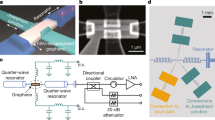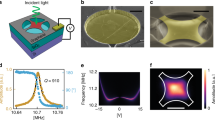Abstract
Light absorption in graphene causes a large change in electron temperature due to the low electronic heat capacity and weak electron–phonon coupling1,2,3. This property makes graphene a very attractive material for hot-electron bolometers in the terahertz frequency range. Unfortunately, the weak variation of electrical resistance with temperature results in limited responsivity for absorbed power. Here, we show that, due to quantum confinement, quantum dots of epitaxial graphene on SiC exhibit an extraordinarily high variation of resistance with temperature (higher than 430 MΩ K−1 below 6 K), leading to responsivities of 1 × 1010 V W−1, a figure that is five orders of magnitude higher than other types of graphene hot-electron bolometer. The high responsivity, combined with an extremely low electrical noise-equivalent power (∼2 × 10−16 W Hz−1/2 at 2.5 K), already places our bolometers well above commercial cooled bolometers. Additionally, we show that these quantum dot bolometers demonstrate good performance at temperature as high as 77 K.
This is a preview of subscription content, access via your institution
Access options
Subscribe to this journal
Receive 12 print issues and online access
$259.00 per year
only $21.58 per issue
Buy this article
- Purchase on Springer Link
- Instant access to full article PDF
Prices may be subject to local taxes which are calculated during checkout



Similar content being viewed by others
References
Yan, J. et al. Dual-gated bilayer graphene hot-electron bolometer. Nature Nanotech. 7, 472–478 (2012).
Han, Q. et al. Highly sensitive hot electron bolometer based on disordered graphene. Sci. Rep. 3, 3533 (2013).
Cai, X. et al. Sensitive room-temperature terahertz detection via the photothermoelectric effect in graphene. Nature Nanotech. 9, 814–819 (2014).
Tan, Y. W., Zhang, Y., Stormer, H. L. & Kim, P. Temperature dependent electron transport in graphene. Eur. Phys. J. Spec. Top. 148, 15–18 (2007).
Bolotin, K. I., Sikes, K. J., Hone, J., Stormer, H. L. & Kim, P. Temperature-dependent transport in suspended graphene. Phys. Rev. Lett. 101, 096802 (2008).
Morozov, S. V. et al. Giant intrinsic carrier mobilities in graphene and its bilayer. Phys. Rev. Lett. 100, 016602 (2008).
Zhang, Y. B. et al. Direct observation of a widely tunable bandgap in bilayer graphene. Nature 459, 820–823 (2009).
Yang, Y. F. et al. Low carrier density epitaxial graphene devices on SiC. Small 11, 90–95 (2015).
Averin, D. V., Korotkov, A. N. & Likharev, K. K. Theory of single-electron charging of quantum-wells and dots. Phys. Rev. B 44, 6199–6211 (1991).
Vicarelli, L. et al. Graphene field-effect transistors as room-temperature terahertz detectors. Nature Mater. 11, 865–871 (2012).
Richards, P. L. Bolometers for infrared and millimeter waves. J. Appl. Phys. 76, 1–24 (1994).
Karasik, B. S., McKitterick, C. B. & Prober, D. E. Prospective performance of graphene HEB for ultrasensitive detection of sub-mm radiation. J. Low Temp. Phys. 176, 249–254 (2014).
Boppel, S., Lisauskas, A., Krozer, V. & Roskos, H. G. Performance and performance variations of sub-1 THz detectors fabricated with 0.15 μm CMOS foundry process. Electron. Lett. 47, 661–662 (2011).
Karasik, B. S., Sergeev, A. V. & Prober, D. E. Nanobolometers for THz photon detection. IEEE Trans. Terahertz Sci. Technol. 1, 97–111 (2011).
McKitterick, C. B., Prober, D. E., Vora, H. & Du, X. Ultrasensitive graphene far-infrared power detectors. J. Phys. Condens. Matter 27, 164203 (2015).
Yakes, M. K. et al. Conductance anisotropy in epitaxial graphene sheets generated by substrate interactions. Nano Lett. 10, 1559–1562 (2010).
Ponomarenko, L. A. et al. Chaotic Dirac billiard in graphene quantum dots. Science 320, 356–358 (2008).
Guttinger, J. et al. Transport through graphene quantum dots. Rep. Prog. Phys. 75, 126502 (2012).
Droescher, S., Knowles, H., Meir, Y., Ensslin, K. & Ihn, T. Coulomb gap in graphene nanoribbons. Phys. Rev. B 84, 073405 (2011).
Stampfer, C. et al. Energy gaps in etched graphene nanoribbons. Phys. Rev. Lett. 102, 056403 (2009).
Rinzan, M., Jenkins, G., Drew, H. D., Shafranjuk, S. & Barbara, P. Carbon nanotube quantum dots as highly sensitive terahertz-cooled spectrometers. Nano Lett. 12, 3097–3100 (2012).
Mendis, R. et al. Spectral characterization of broadband THz antennas by photoconductive mixing: toward optimal antenna design. IEEE Antenn. Wirel. Pr. 4, 85–88 (2005).
Nyakiti, L. O. et al. Enabling graphene-based technologies: toward wafer-scale production of epitaxial graphene. MRS Bull. 37, 1149–1157 (2012).
Acknowledgements
The work at Georgetown University was supported by the US Office of Naval Research (award no. N000141310865) and by the Air Force Office of Scientific Research (DURIP FA9550-09-1-0434). Work at NRL was supported by the US Office of Naval Research. A.K.B. is grateful for an American Association of Engineering Education post-doctoral fellowship and K.M.D. is a National Research Council Fellow. The devices were fabricated in the Georgetown Nanoscience and Microtechnology Laboratory. The authors thank H. D. Drew, A. B. Sushkov, T. E. Murphy, M. S. Fuhrer, Y. Yang and R. Elmquist for discussions.
Author information
Authors and Affiliations
Contributions
A.E.F. fabricated the devices and performed the transport measurements. A.K.B., K.M.D., R.L.M.-W. and D.K.G. synthesized and characterized the graphene on SiC. A.E.F. and P.B. designed the experiment and analysed the data. All authors contributed to the discussion of the results and preparation of the manuscript.
Corresponding authors
Ethics declarations
Competing interests
The authors declare no competing financial interests.
Supplementary information
Supplementary information
Supplementary information (PDF 1319 kb)
Rights and permissions
About this article
Cite this article
El Fatimy, A., Myers-Ward, R., Boyd, A. et al. Epitaxial graphene quantum dots for high-performance terahertz bolometers. Nature Nanotech 11, 335–338 (2016). https://doi.org/10.1038/nnano.2015.303
Received:
Accepted:
Published:
Issue Date:
DOI: https://doi.org/10.1038/nnano.2015.303
This article is cited by
-
Ultra-broadband photoconductivity in twisted graphene heterostructures with large responsivity
Nature Photonics (2023)
-
Terahertz Beam Steering: from Fundamentals to Applications
Journal of Infrared, Millimeter, and Terahertz Waves (2023)
-
Synthesis of graphene quantum dots from organic dye for the biosensor application
Carbon Letters (2023)
-
THz Imaging Technology Trends and Wide Variety of Applications: a Detailed Survey
Plasmonics (2023)
-
Progress in performance development of room temperature direct terahertz detectors
Journal of Infrared, Millimeter, and Terahertz Waves (2022)



